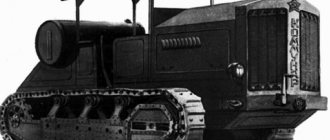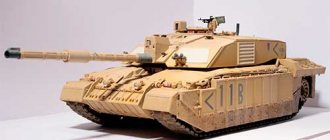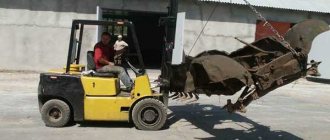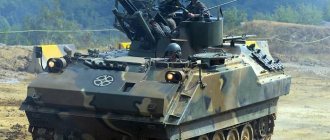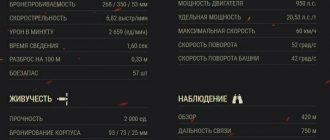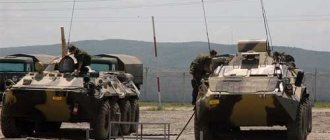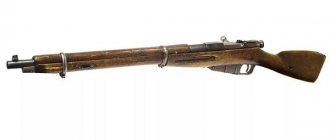| Universal Carrier | |
| Universal Carrier | |
| Classification | armored personnel carrier |
| Combat weight, t | 3.8 (without weapons)[1] |
| Layout diagram | engine compartment at the rear left, transmission and controls at the front, landing compartment at the rear right |
| Crew, people | 1 |
| Troops, people | 3—4 |
| Story | |
| Years of production | 1936—1945 |
| Years of use | 1936—1962 |
| Number of issued, pcs. | about 113,000 |
| Basic operators | |
| Dimensions | |
| Case length, mm | 3657 |
| Width, mm | 2057 |
| Height, mm | 1588 |
| Ground clearance, mm | 203 |
| Booking | |
| Armor type | rolled steel |
| Body forehead, mm/deg. | 10[1] |
| Hull side, mm/deg. | 7[1] |
| Hull feed, mm/deg. | 7 |
| Bottom, mm | 4 |
| Housing roof, mm | open |
| Armament | |
| Machine guns | on most vehicles - 1 × 7.7 mm Bren or 1 × 13.9 mm Boys PTR |
| Mobility | |
| engine's type | V-shaped 8-cylinder carburetor liquid cooled |
| Engine power, l. With. | 85 |
| Highway speed, km/h | 48[1] |
| Cruising range on the highway, km | 225 |
| Specific power, l. s./t | 19 |
| Suspension type | on helical coil springs, interlocked in pairs (Horstmann type (English)) and individual |
| Climbability, degrees. | 28 |
| Wall to be overcome, m | 0,5 |
| Ditch to be overcome, m | 1,3 |
| Fordability, m | 0,6 |
Universal Carrier
(translated from English as “Universal Transporter”) is a British light multi-purpose armored personnel carrier of the 1930s and the Second World War.
Story
Created by Vickers-Armstrong in 1934-1936 on its own initiative[1] and was intended to carry various weapons, primarily machine guns, one of which gave the vehicle its common name.
The first two vehicles were purchased for the British army in 1935, serial production of the Universal Carrier continued from 1936 to 1945, and already in 1937-1938, based on the results of use in the army, changes were made to the design of the armored vehicle[1].
In September 1938, the Universal Carrier armored vehicles, armed with a Bren machine gun, entered service with the troops and were presented to the public and journalists at brigade exercises of the British army. During the exercises, the vehicles demonstrated high maneuverability and the ability to successfully overcome hedges and dense thickets of bushes[2].
The Universal Carrier was the main British and Commonwealth armored personnel carrier in World War II and was used in a variety of roles - infantry armored personnel carrier, weapons carrier, ammunition carrier, artillery tractor, reconnaissance vehicle and others. A significant number of vehicles were also supplied to Great Britain's European allies during the war[3]. After the war, the Universal Carrier remained in British service until the 1950s and was used in the Korean War, as well as being supplied to a number of other countries, some of which only retired it from service in the 1960s.
Armored personnel carrier "Universal"
Universal Carrier
The main armored personnel carrier of the armies of the countries of the British Commonwealth of Nations and the most popular armored personnel carrier of the Second World War. Developed by Vickers-Armstrong in the mid-30s on the basis of the Vickers Carrier Mk I artillery tractor and machine-gun carrier using elements of the chassis and suspension of the Vickers-Carden-Loyd light tank. It was produced by English, Canadian, Australian and New Zealand companies, and was also produced in the USA under British orders. From 1937 to 1945, about 90,000 units were manufactured.
SERIAL MODIFICATIONS: Bren Carrier Mk 1(11) – the basic version of an armored personnel carrier for infantry. Combat weight 3.75 tons, armor 10 mm, crew 4 people. Armament: 7.7 mm Bren machine gun. From 1938 to 1940, Thornycroft produced 1,173 units.
Scout Carrier – reconnaissance version. Compared to the basic one, it was additionally equipped with radio station No. 11 and a Boys anti-tank rifle. Only the starboard side was armored. Crew 3 people. 647 units produced.
Cavalry Carrier is a modification intended for mechanized cavalry regiments. The sides were unarmored, radio station No. 11 and a protective awning were installed. Crew 6 people. 50 units produced.
AOR Carrier Mk 1(11) is a forward artillery observer vehicle. Structurally and in layout it is similar to the Cavalry Carrier. 95 units produced.
Universal Carrier Mk I(II, III) - the main serial English version. A welded body with a simple rectangular shape, open at the top, and a chassis with three road wheels. Cars of different years of production had minor differences in the design of the power plant, hull and equipment.
Universal Carrier Mk I (C01UC) is a Canadian version of an armored personnel carrier, identical in design and appearance to the English version. Combat weight 3.56 tons, Ford V-8 engine with 85 hp. In addition to the main one, the C21UCM (self-propelled 3-inch mortar) and C21UCG (self-propelled 2-pounder anti-tank gun; 20 units in 1942) variants were produced. From 1941 to 1945, Ford Motor Co and Dominion Bridge Co produced 28,992 units.
MG Carrier (LP Ns 1, 2, 2A) - a variant produced in Australia. The welded hull and chassis are similar to the Universal Carrier Mk I. Combat weight 3.68 tons, Ford V-8 engine producing 95 hp. 5,500 units produced.
Loyd Carrier is a version with four road wheels, developed in 1940 by the English company Vivian Loyd & Co. Combat weight 3.78 tons, dimensions 4140x2070x1422 mm. Ford V-8 engine rated at 85 hp. at 3500 rpm. In addition to the English ones, American Ford engines with 85, 90 and 95 hp were installed on some of the vehicles. Manufactured by Loyd, Dennis, Ford (4213 units in 1943 - 1944), Sentinel and Wolseley.
Windsor Carrier Mk I (C49WC) is a Canadian four-wheel armored personnel carrier. Combat weight 4.67 tons, dimensions 4370x2110x1450 mm (height with awning - 2030 mm). Ford V-8 engine 95 hp, speed 50 km/h. In 1944-1945, Ford Motor Co and Canadian Bridge Co produced 5,000 units.
Universal Carrier T16 is an American version of an armored personnel carrier, developed to British order. The hull is similar to the Universal Carrier Mk I. The chassis has four road wheels. Combat weight 4.76 tons, dimensions 3860x2110x1550 mm. Ford GAU-T16 engine with 100 hp power. at 3600 rpm, max. speed 48.3 kmL. Crew 5 people. From 1943 to 1945, 13,893 units were manufactured.
Carrier armored personnel carriers of various modifications were used by British, Canadian, Australian, New Zealand and Indian troops in all theaters of World War II from 1939 to 1945. During the “Battle of France” (1939-1940), the British Expeditionary Force included 7 mechanized cavalry regiments, each with 44 armored personnel carriers of various modifications. In addition, 31 vehicles were in tank units. During the evacuation of British troops from Dunkirk, all this equipment was left to the enemy. Since 1941, Universal Carrier armored personnel carriers were available in all British infantry and tank units in the metropolis, and also actively fought in North Africa in the 1st and 8th armies.
During the Normandy landings and subsequent hostilities on the European continent, in addition to transporting infantry, vehicles of this type were used as tractors for 6-pounder guns in anti-tank platoons, for transporting Vickers heavy machine guns in machine-gun platoons, as well as in control companies of motorized battalions. A small number of British and Canadian-made armored personnel carriers were converted into flamethrower versions of the Wasp and Ronson.
In addition to the troops of the British Commonwealth countries, the Universal Carrier armored personnel carriers entered service with the military units of the Free French, China, Poland, Czechoslovakia and the USSR. Under the Lend-Lease program, 2008 armored personnel carriers were delivered to the Soviet Union, which were in service with motorcycle reconnaissance battalions, motorcycle regiments and tank brigades of mechanized corps. In the Red Army, “station wagons” were used until the end of 1945. 51 armored personnel carriers were transferred to the Polish Army. After the end of hostilities in Europe, the Poles were left with 39 vehicles, which were in service until the end of 1946. Universal Carrier armored personnel carriers were also available in both Polish corps that fought in the West. A number of combat vehicles of this type were part of the Czechoslovak Tank Brigade in the West. After the end of World War II, they were used by the Czechoslovak army until the early 50s. In the post-war years, T16 armored personnel carriers were in service with the armies of Argentina and Switzerland.
As for Great Britain itself, a significant number of armored personnel carriers of all the above modifications remained in service with the British army until the mid-50s. The Canadians also exploited them for quite a long time. As part of British and Canadian units, these vehicles took part in the Korean War.
TACTICAL AND TECHNICAL CHARACTERISTICS
COMBAT WEIGHT, t; 3.7. CREW, people: 4-5. DIMENSIONS, mm: length – 3657, width – 2057, height – 1588, ground clearance – 203. ARMAMENT: 1 Boys anti-tank rifle of 13.97 mm caliber, 1 Bren machine gun of 7.7 mm caliber (a Bren anti-aircraft machine gun could be installed). AMMUNITION: 80 rounds of 13.97 mm caliber, 900 rounds of 7.7 mm caliber. RESERVATION, mm: front-10, side and stern-7. ENGINE: Ford QAE, 8-cylinder, carburetor, four-stroke, V-shaped, liquid cooling; power 60 hp at 2840 rpm; working volume 3600 cm3. TRANSMISSION: single-disc main dry friction clutch, four-speed gearbox (4+1), differential. CHASSIS: three rubberized track rollers on board (two front ones are interlocked, the rear one is independent), suspended on spiral springs (Horstmann type suspension), one support roller, an idler wheel, a rear drive wheel (lantern engagement); each caterpillar has 160-167 tracks with a width of 241 mm, track pitch is 43 mm. MAX. SPEED, km/h: 40. POWER RESERVE, km: 180. OBSTACLES OVERCOME: climb angle, degrees. – 28, wall height, m – 0.5, ditch width, m – 1.6, ford depth, m – 0.6. COMMUNICATIONS: radio station No. 11.
Production
In total, about 90,000 armored personnel carriers of this type were produced, making it one of the most popular armored vehicles in history.
Look:
Barun-Khemchiksky kozhuun
In the UK it was produced by several companies, among them Ford of Great Britain. By 1945 production amounted to approximately 57,000 of all variants. In addition, the Universal Carrier was produced in Canada (29,000 units), Australia (about 5,000), New Zealand (about 1,300) and the USA (about 20,000, not counting the T16).
Despite the big drawback - insufficient firepower, Universal Carrier armored personnel carriers were used for reconnaissance and combat security tasks.
"Universal Carrier", captured and converted by detachments of Indonesian nationalists during the battles on the island. Java.
Options and modifications
- Bren Carrier
(English: “Bren carrier”) - the main version, the weapon is a 7.71 mm Bren machine gun[3] - Wasp
- self-propelled flamethrower[3] - 3 inch Mortar Carrier (Aust)
- self-propelled 76.2 mm mortar (produced in Australia) - 2-pounder Anti-tank Gun Carrier (Aust)
- Universal Carrier, armed with a British 40 mm QF 2 pounder gun (produced in Australia) - T16
- a modified version (with four rollers and a Ford Mercury engine), which was produced in the USA - Munitionschlepper Bren (e)
- a captured Universal Carrier, used by the Wehrmacht as an ammunition transporter since 1940 (without making any changes to the design)[4] - Munitionschlepper Bren mit MG.08 (e)
- a captured Bren Carrier, on which, instead of a Bren machine gun, a 7.92 mm MG 08 heavy machine gun was installed. Used by the Wehrmacht since 1941[4] - 3.7 cm PAK 35/36 auf Sfl.
Bren (e) - 37 mm anti-tank gun mod. 1935/36 on the Universal Carrier chassis[5], some produced in 1941[4] - Schneeschafel auf Sfl.
Bren (e) - captured Universal Carrier, equipped with a bulldozer blade. A certain number were converted and transferred to the Luftwaffe in 1941, intended for clearing snow from airfields[4] - Feld Ladungstraeger Bren (e)
is a remote-controlled vehicle for transporting an explosive charge with the ability to remotely detonate the charge. Developed in 1942[4] - "Praying Mantis"
- an experimental prototype of 1943-1944, in which the machine gunner was in a cabin with a lift (which was supposed to provide the ability to fire over obstacles), was not mass-produced. One prototype is in the Armored Vehicle Museum in Bovington, another in the National War Museum in Sosteberg[6]
In December 1943, the GABTU of the Red Army ordered the replacement of weapons with the Universal Carrier remaining in the troops, according to which the British 7.71-mm Bran machine guns and 13.9-mm Boyce anti-tank rifles were replaced with Soviet 7.62-mm machine guns DT and 14.5 mm anti-tank rifles[7].
Self-propelled guns based on the English armored personnel carrier - "Universal Carrier" tractor
Home » Real story » History of Wars » Self-propelled guns based on the English armored personnel carrier - “Universal Carrier” tractor
History of Wars
Hoplite 01/31/2018 1221
2
in Favoritesin Favoritesfrom Favorites 0
Having become interested in the English “Universal Carrier”, I found a lot of interesting things on the Internet.
Firstly, it is not entirely clear in which country the Universal Carrier 2-pdr bp self-propelled gun was created, which fights in WoT and which is depicted on the cover: the wiki says that in Australia, another article says that in Canada, and I did not find Year of release.
Several photographs of a Canadian self-propelled gun based on the Universal Carrier, armed with a 2-pounder cannon; I have already provided a photograph of this sample. In Canada, the self-propelled gun was given the designation C21UCG; only 20 units were produced. The vehicle did not take part in combat operations, but was used to train crews of tank destroyers.
Tests of Carrier Machine Gun No2 Mk I with a 2-pounder anti-tank gun installed. I don’t know when these tests took place and why the car didn’t go into production.
Anti-tank self-propelled guns based on the Universal Carrier armored personnel carrier; early 40s
This self-propelled gun was manufactured by Australian specialists by “crossing” the 40-mm Ordnance QF 2-pounder anti-tank gun and the Universal Carrier armored personnel carrier (in this case, the body of the armored personnel carrier had to be lengthened, and a couple more rollers were added to its chassis). In total, about 200 machines of this type were manufactured.
I did not find any information about participation in hostilities.
In the photos and drawings from other sources, I didn’t notice an extra pair of rollers.
What do you think of this monster (some kind of Smith Gun Carrier)?
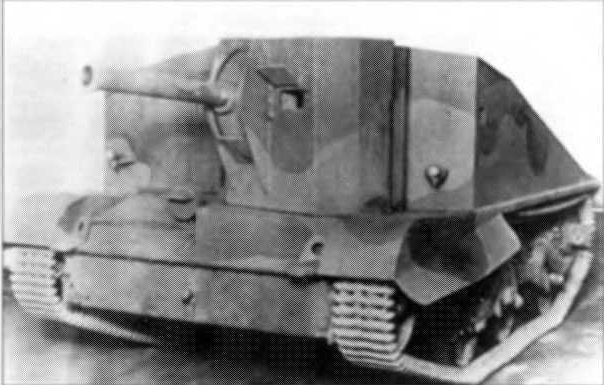
Soviet with a DShK machine gun:
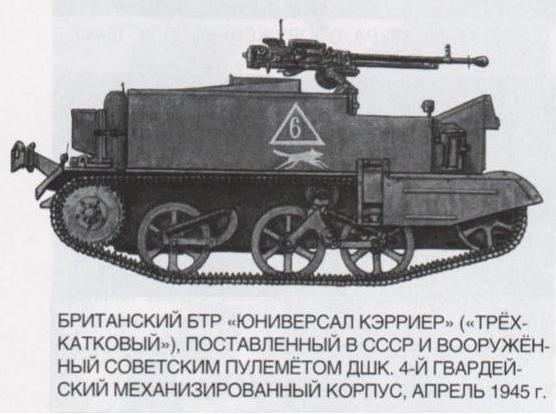
Post-war modifications.
The Danish Universal Carrier Mark II armored personnel carrier has a 106 mm recoilless rifle.
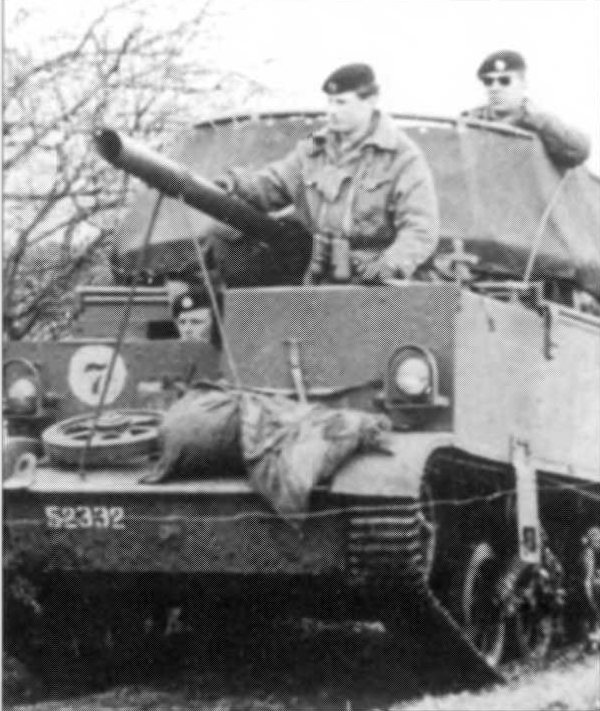
Another vehicle with a recoilless rifle.

And the carrier of anti-tank missiles (I didn’t find out which country and what kind of missiles):
A separate topic is German improvised self-propelled guns based on captured Universals, primarily captured by the Germans in France.
I found some interesting photos on the topic online. In the first, French prisoners of war free a road blocked by the British with their Bren Gun Carrier. Dunkirk area, late May 1940.
The road is clear, the Germans continue their offensive.
The third photo shows the same Dunkirk, with the first model of the Universal Carrier abandoned on the beach. Next to the armored personnel carrier is a French patrol boat armed with a 75-mm field gun model 1897 on an anti-aircraft mount.
German paratroopers on a captured English Bren-Carrier armored personnel carrier. Crete, 1941.
Various German units were armed with the English Universal Carrier tracked armored personnel carriers (gepanzerter Maschinen-gewehrtrager Bren 731(e). Some of the vehicles were rearmed or re-armed. The best known options are the 20-mm automatic anti-aircraft gun Flak 38 and the 37-mm anti-tank gun - Pak 35 /36. Both were installed in the back of an armored personnel carrier with their standard shields. In the 3rd motorized division of the Wehrmacht, several armored personnel carriers were armed with a package of three barrels of an 88-mm rocket-propelled grenade launcher (8.8 cm Raketenpanzerbuschse 43). In addition, captured English Armored personnel carriers were used by the Luftwaffe to clear snow from runways, equipped with a bulldozer blade, and were used by various police forces for patrol duty.
Collection of trophies.
German anti-tank self-propelled guns, manufactured by mounting 47 mm Böhler M35 anti-tank guns mounted on the chassis of Universal Carrier armored personnel carriers, using shields from the 25 mm French SA-L anti-tank gun and 40 mm British QF 2 pounder anti-tank guns; German troops in France; ~ 1940-1944
German conversion of the English armored personnel carrier Universal Carrier. The vehicle is equipped with a French 25 mm anti-tank gun of the 1934 model - Canon 25 mm SA Mle 1934. It was made in Africa in a single copy.

Although I found a photo of a burnt “Universal” with the same gun, but with a “classic” arrangement:
In the end there is a drawing with the “classic” modifications of the “Universal”; the result is a truly universal car.
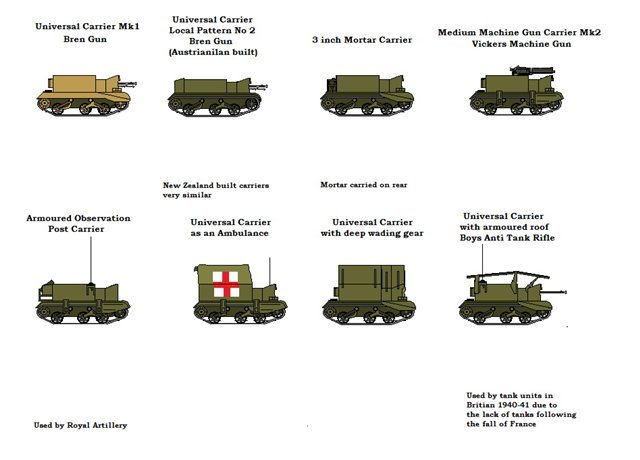
Sources:
- • https://popgun.ru/viewtopic.php?f=147&t=250346&start=90
- • https://477768.livejournal.com/2503685.html
- • https://forum.guns.ru/forum_light_message/42/309614.html
- • https://topwar.ru/28545-trofeynaya-bronetankovaya-tehnika-vermahta-velikobritaniya.html
- • https://477768.livejournal.com/4002092.html
- • https://beutepanzer.ru/Beutepanzer/uk/APC_universal/universal-AT4.html
- • https://vsetanki.com/tank_info/256/
Operation and combat use
- Great Britain - was in service with the British army, supplied to the dominions and colonies[1]
- Third Reich - a significant number of captured vehicles were used during the Second World War in various modifications[4]
- USSR - the question of the possibility of sending a batch of Bren Carrier wedges to the USSR under the Lend-Lease program was submitted for consideration on September 29, 1941 [8], on October 1, 1941, the decision to supply a batch of three-ton machine-gun wedges (with machine guns) from Great Britain to the USSR was approved[9]
- Republic of China - supplied under the Lend-Lease program
- Yugoslavia - during the capture of Greece in April 1941, German troops had at their disposal the equipment of the British Expeditionary Force (including a number of Bren Carrier tankettes). During the fighting against the German forces of Army Group E in 1945, at least one captured tankette of this type was captured in serviceable condition, it was armed with an MG-34 machine gun and was used by the NOAU[10]
Dynamics of receipt, losses and availability of armored personnel carrier MK-1 ("Bren") in the Red Army (TsAMO RF)
| Received | Written off | Availability | |
| 1.1.1944 | 1636 | 1152 | 484 |
| 1.7.1944 | 344 | 34 | 794 |
| 1.1.1945 | 7 | 14 | 787 |
| 1.6.1945 | 16 | 40 | 763 |
Look:
Krokow, Christian von
By June 1, 1945, the Red Army had 763 vehicles, of which 458 were in front-line units, 145 in military districts and 160 in repair factories.
From the number of decommissioned vehicles, 51 vehicles transferred to the Polish Army should be excluded.
Light multi-purpose armored personnel carrier Universal Carrier
"Battle Buses"
By the time the Second World War began, the English view of armored personnel carriers had undergone major changes. If the first armored personnel carrier in history, created in Great Britain at the end of the First World War, was distinguished by its monstrous dimensions and was a remake of the first diamond-shaped English tanks, then by the mid-1930s the main armored personnel carrier of the British army became the miniature tracked Universal Carrier, the closest relative of which was the Carden tankettes Loyd.
Unlike its predecessor, the Mark IX tracked armored personnel carrier, of which about three dozen were produced, the new armored personnel carrier was produced in a huge series in different countries - approximately 113 thousand units, which made the Universal Carrier one of the most popular armored vehicles in history. For the entire period of the war, the “Universal Transporter” became the main armored personnel carrier of the armies of Great Britain and the Commonwealth countries. The new British armored personnel carrier was a small tracked armored vehicle weighing up to 3.8 tons, the number of paratroopers transported was limited to 3-5 soldiers, while the Mark IX armored personnel carrier created at the end of the First World War could transport up to 30 soldiers. Despite the insufficient firepower and small landing capabilities, the new armored personnel carrier could be produced in huge quantities, and at the front the Universal Carrier was used to solve a variety of combat missions. In addition to directly transporting infantry, the vehicles were used for reconnaissance, deployed as combat guards, used for transporting cargo and wounded soldiers, and also as tractors for light artillery systems.
The history of the creation of the most popular armored personnel carrier of World War II
The most popular armored personnel carrier of the Second World War was developed on its own initiative by engineers of the British company Vickers-Armstrong in 1934-1936. The new combat vehicle was a modernized and updated version of the family of light English Carden Loyd wedges, created back in the 1920s, in particular the Vickers Carden-Loyd Mk.VI wedge, which was an infantry armored personnel carrier. Initially, the “Universal Transporter” was created as a carrier of various weapons, primarily machine gun systems. At the same time, it is already clear from the name that the car was versatile. In addition to transporting a machine gun and troops, the armored personnel carrier could be used to transport light field weapon systems along with the crew. At different times, a reconnaissance version, an artillery observer vehicle, an artillery tractor for transporting mortars and light guns, and a vehicle for transporting ammunition were created. In addition, the Universal Carrier carried various weapons, including flamethrowers and anti-tank rifles.
The British Army purchased the first two vehicles already in 1935, and from 1936 mass production of early series armored vehicles began, which did not stop until 1945, and the armored personnel carriers themselves were used until the early 1960s. In addition to the UK, where approximately 57 thousand universal transporters were assembled, they were massively assembled at enterprises in Canada (29 thousand vehicles) and Australia (5 thousand vehicles), and about 20 thousand transporters were also assembled at enterprises in the USA. The American version was distinguished by an improved chassis, which received a second full-fledged wheeled bogie, as well as the installation of American Ford engines of greater power.
The operation of vehicles in the army led to changes in their design, so already at the turn of 1937-1938, Universal Carrier armored personnel carriers underwent a number of changes. The full public debut of the new armored vehicles came in September 1938, when the first production “Universal Transporters”, armed with a 7.7 mm Bren machine gun, were presented to ordinary people and journalists during brigade exercises of the British Army. During the exercises, the vehicles demonstrated good cross-country ability and high maneuverability. The tracked armored vehicles had no problems when used in rural areas, confidently overcoming dense bushes, hedges and fences. Nothing more was required from such technology.
The number of armored personnel carriers produced indicates that the vehicle was simple and easy to manufacture, and also satisfied the needs of the military, who received a combat vehicle that was easy to learn and operate, capable of solving a variety of tasks. A large number of armored vehicles also came to the Soviet Union as part of the Lend-Lease program. In total, the USSR received more than 2,500 such transporters, 200 of them before the end of 1941. In the Soviet Union, vehicles were re-equipped with domestic models of weapons from December 1943. Thus, the 7.7 mm Bren machine gun was replaced by a 7.62 mm DT machine gun, and the 13.9 mm Boys anti-tank rifle by 14.5 mm PTRD and PTRS anti-tank rifles.
Technical features of the Universal Carrier armored personnel carrier
Like the lightweight Carden Loyd wedges, the new British armored personnel carriers were distinguished by the recognizable low, open-top hull of a simple rectangular shape.
The main purpose of the armored vehicles was to transport Bren and Vickers machine guns, but the military itself quickly cooled down to this role of using light armored vehicles, finding a lot of applications for the “Universal Transporters” in army service. The total combat weight of the vehicles did not exceed 3.8 tons. When creating armored vehicles, rolled steel armor plates were used, but their thickness was very small: 10 mm in the frontal part of the hull and 7 mm along the sides and rear. We can say that the armor was symbolic, protecting the vehicle and crew from small fragments and non-armor-piercing rifle-caliber bullets. The body length of the Universal Carrier armored personnel carrier was 3.65 m, width – 2.06 m, height – 1.57 m, ground clearance – 203 mm. The vehicle was squat and easily hidden in folds of terrain and behind bushes, which in some cases, especially when used as a reconnaissance vehicle, was an advantage. The heart of the armored vehicle was an 8-cylinder liquid-cooled gasoline engine with a volume of 3.9 liters. The engine produced a maximum power of 85 hp. at 3500 rpm. This was enough to accelerate the “Universal Transporter” to 48 km/h when driving on the highway. Considering the low engine power, this is quite a decent indicator for tracked vehicles. The range when driving on the highway was estimated at 225-250 km. Thanks to the low specific pressure on the ground - approximately 0.45 km/cm2 - the armored personnel carrier was distinguished by good maneuverability in various types of terrain.
The chassis of all English vehicles, the most popular of which were the Universal Carrier Mk I (II, III), consisted of three road wheels on each side, the first pair was combined into a bogie. The chassis and suspension were derived from the 1930s British Light Tank Mk.VI with minor modifications, also produced by Vickers. The armored personnel carrier's suspension also used coil springs, and the suspension itself was known as Horstmann, named after the inventor Sidney Horstmann, who came up with it back in 1922. Later, on the American versions of the transporter, designated T16, the chassis was improved, the composition of the road wheels was increased to four per side, which made it possible to form two full-fledged bogies.
An unusual feature of the Universal Carrier was the location of the engine, which was located at the rear of the vehicle, the engine was installed along the central axis of the hull. There in the power compartment there was a five-speed gearbox and onboard clutches. In the front part of the hull there was a control compartment, where the driver and machine gunner or anti-tank rifle operator were located, depending on the composition of the installed weapons. Behind the control compartment there was a landing or transport compartment, depending on the modification. Typically, the Universal Carrier carried no more than three to five people.
At the same time, the location of the engine in the middle of the hull divided the landing compartment into two parts. The paratroopers sat with their backs to the sides of the armored personnel carrier, actually resting their feet on the engine, the upper part of which formed a kind of “table top.” With a different seat arrangement, the paratroopers rested their side against the engine protection. Considering the small dimensions of the Universal Carrier armored personnel carrier, the location of people in the hull should not be considered the most convenient. For example, in the hot climate of North Africa, the paratroopers received constant additional heating, which hardly improved their well-being, even despite the open hull. At the same time, in winter in Europe, especially in the northern regions of the USSR, such a “stove” was a help for paratroopers, and the shooter and driver, who did not have such a heater at their disposal in the control department, should have envied them.
After the end of the Second World War, service of the Universal Carrier armored personnel carriers in the British Army continued until the 1950s. They managed to take part in hostilities during the Korean War. At the same time, some armored vehicles were delivered to third countries, where they continued to be in service until the 1960s. A large number of such transporters of various modifications and production in different countries have survived to this day. For example, in Russia, the armored tank museum in Kubinka displays a flamethrower modification of the Universal Carrier armored personnel carrier.
In computer games
In the multiplayer game World of Tanks, the Universal Carrier 2-pounder Anti-tank Gun Carrier (UC 2-pdr) is located in the British branch of tank destroyers at level 2.
In the multiplayer game Wild Tanks Online, Universal Carrier is located in the British branch of tank destroyers at level 3.
In the computer game Company of Heroes 2, 3 variants of this armored personnel carrier are available: Universal Carrier, Bren Carrier and Wasp.
In the multiplayer mode of Red Orchestra 2, this armored personnel carrier, equipped with a DT machine gun, is available to players for the Red Army on some maps.
In the single-player mode of Call of Duty 2, this armored personnel carrier appears in certain missions of the British company.
Notes
- ↑ 1234567
Development of the wedge // magazine “Technology for Youth”, No. 9, 1979. pp. 42-43 - ↑ Tests of machine gun carriers in the British army // Izvestia, No. 219 (6686) dated September 18, 1938. p.2
- ↑ 123
L. D. Gogolev. Armored vehicles. Essays on the history of development and combat use. M., DOSAAF, 1986. pp.82-83 - ↑ 123456
Peter Chamberlain, Hilary Louis Doyle. Self-propelled weapons of the German Army 1939-45. Handbook No.1 Part II — Foreign-built fully tracked chassis. MAP Publications, 1971. page 24 - ↑ TJ Gander. German Anti-Tank Guns. London, Altmark Publications Ltd., 1973. page 61
- ↑ D. Pichugin. National Military Museum of the Netherlands // magazine "Equipment and Weapons", No. 12, 2016. pp.53-56
- ↑ S. L. Fedoseev. Russian machine guns. Heavy fire. M., Yauza - EKSMO, 2009. p.184
- ↑ Record of the conversation between the Chairman of the Council of People's Commissars of the USSR and the heads of the delegations of Great Britain and the USA at the Moscow Conference of Representatives of the Three Powers on September 29, 1941 // Soviet-English relations during the Great Patriotic War, 1941-1945: documents and materials. in 2 vols. Volume 1. 1941-1943 / Ministry of Foreign Affairs of the USSR. - Politizdat, 1983. pp. 132-136
- ↑ Secret protocol of the Moscow conference of representatives of the USA, USSR and Great Britain on October 1, 1941 // Soviet-English relations during the Great Patriotic War, 1941-1945: documents and materials. in 2 vols. Volume 1. 1941-1943 / Ministry of Foreign Affairs of the USSR. - Politizdat, 1983. pp. 140-146
- ↑ Blinde to the Balkan // Arsenal (Serbia), No. 38, February 2010. pp. 11-16
